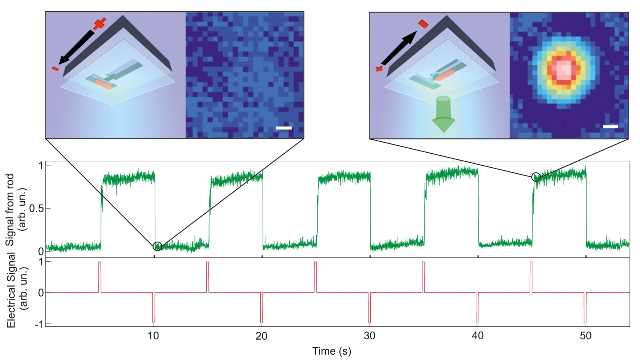A team of researchers at the University of Zurich has succeeded in arranging and controlling colloid motion with the great speed and precision.
 A nanorod is switched between two states -- bright (high signal) and dark (low signal) by an external electrical pulse (red trace). The state of the rod can be readout instantaneously at any time using polarized light. The rod stores the most recently written state until the arrival of the next «write pulse». (Image: UZH)
A nanorod is switched between two states -- bright (high signal) and dark (low signal) by an external electrical pulse (red trace). The state of the rod can be readout instantaneously at any time using polarized light. The rod stores the most recently written state until the arrival of the next «write pulse». (Image: UZH)
Colloids are small particles that are lightly dispersed throughout a solution. With this latest method, colloidal nanoparticles offer potential applications in future digital technologies. Nanoparticles are suitable for high-resolution displays or innovative data storage applications as they can be quickly and easily relocated and do not need large amounts of energy. Also, these particles have a small footprint, which allows for bulk storage capacity.
A few examples of colloidal suspensions include paints, cosmetics, and beverages. A single colloidal particle measures in the diameter range of 10 to 100 nm, and hence cannot be seen with the naked eye. Due to the law of Brownian motion, these particles move continuously. As these nanoparticles are electrically charged, they are subject to forces of repulsion and attraction which can be leveraged to manipulate and control their behavior.
Some years ago, Madhavi Krishnan, Physical Chemistry Professor at the University of Zurich, performed several experiments and was successfully able to control the spatial manipulation of colloidal matter at the nanoscale. Along with her colleagues, Krishnan carried out new research which revealed that nanoparticles can be spatially restricted, and their direction and position in time can also be controlled, even in a solution with no physical contact.
A new technique developed by the UZH research team can be applied to produce and manipulate nanostructures in a flexible manner. The researchers arranged the small particles into innovative structures with high speed and accuracy, and effectively controlled the particles’ motion. Madhavi Krishnan said that manipulation was achieved through interaction with optical and electrical fields. Since the latest method uses intermolecular interactions at room temperature, it eliminates the need for ultralow temperatures. Moreover, the novel technology allows low-friction and rapid operation.
Thanks to the latest technique, innovative materials and devices could possibly be developed. Madhavi Krishnan explained that individual nanoparticles can now be used to store and recover information, and their unique properties prove useful for digital technologies. This focused manipulation of each particle paves the way for new applications in new and future data storage media, or in displays with resolutions which, until now, have been difficult to achieve. This could give displays like that of the Kindle a more rapid response time and a pixel size that is many times smaller, concluded Madhavi Krishnan.